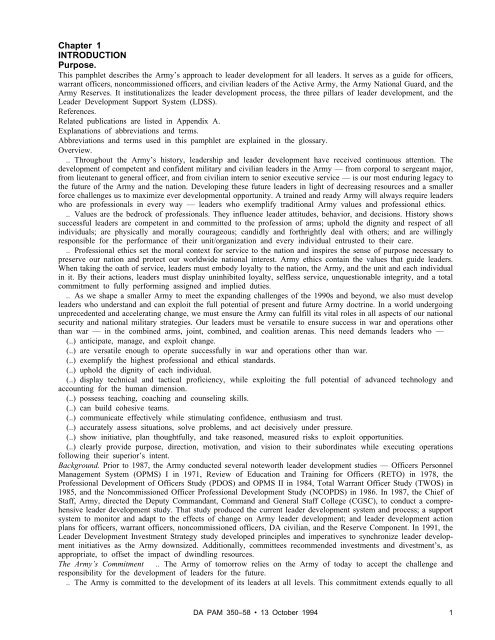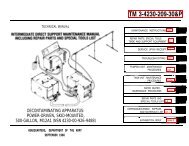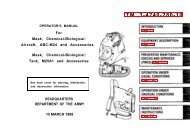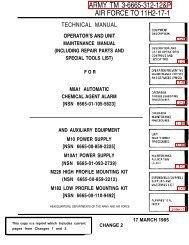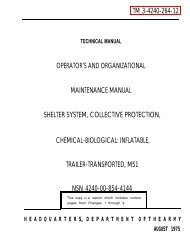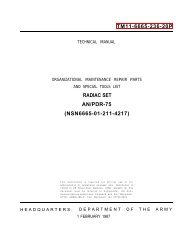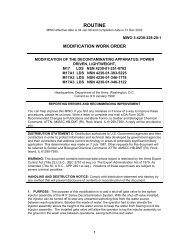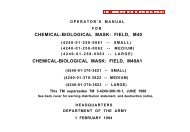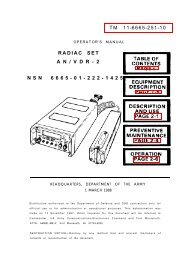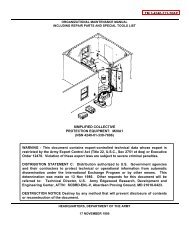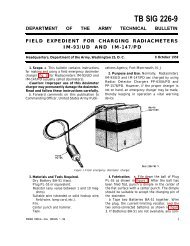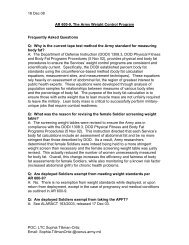LEADER DEVELOPMENT FOR AMERICA'S ARMY
LEADER DEVELOPMENT FOR AMERICA'S ARMY
LEADER DEVELOPMENT FOR AMERICA'S ARMY
Create successful ePaper yourself
Turn your PDF publications into a flip-book with our unique Google optimized e-Paper software.
Chapter 1<br />
INTRODUCTION<br />
Purpose.<br />
This pamphlet describes the Army’s approach to leader development for all leaders. It serves as a guide for officers,<br />
warrant officers, noncommissioned officers, and civilian leaders of the Active Army, the Army National Guard, and the<br />
Army Reserves. It institutionalizes the leader development process, the three pillars of leader development, and the<br />
Leader Development Support System (LDSS).<br />
References.<br />
Related publications are listed in Appendix A.<br />
Explanations of abbreviations and terms.<br />
Abbreviations and terms used in this pamphlet are explained in the glossary.<br />
Overview.<br />
.. Throughout the Army’s history, leadership and leader development have received continuous attention. The<br />
development of competent and confident military and civilian leaders in the Army — from corporal to sergeant major,<br />
from lieutenant to general officer, and from civilian intern to senior executive service — is our most enduring legacy to<br />
the future of the Army and the nation. Developing these future leaders in light of decreasing resources and a smaller<br />
force challenges us to maximize ever developmental opportunity. A trained and ready Army will always require leaders<br />
who are professionals in every way — leaders who exemplify traditional Army values and professional ethics.<br />
.. Values are the bedrock of professionals. They influence leader attitudes, behavior, and decisions. History shows<br />
successful leaders are competent in and committed to the profession of arms; uphold the dignity and respect of all<br />
individuals; are physically and morally courageous; candidly and forthrightly deal with others; and are willingly<br />
responsible for the performance of their unit/organization and every individual entrusted to their care.<br />
.. Professional ethics set the moral context for service to the nation and inspires the sense of purpose necessary to<br />
preserve our nation and protect our worldwide national interest. Army ethics contain the values that guide leaders.<br />
When taking the oath of service, leaders must embody loyalty to the nation, the Army, and the unit and each individual<br />
in it. By their actions, leaders must display uninhibited loyalty, selfless service, unquestionable integrity, and a total<br />
commitment to fully performing assigned and implied duties.<br />
.. As we shape a smaller Army to meet the expanding challenges of the 1990s and beyond, we also must develop<br />
leaders who understand and can exploit the full potential of present and future Army doctrine. In a world undergoing<br />
unprecedented and accelerating change, we must ensure the Army can fulfill its vital roles in all aspects of our national<br />
security and national military strategies. Our leaders must be versatile to ensure success in war and operations other<br />
than war — in the combined arms, joint, combined, and coalition arenas. This need demands leaders who —<br />
(..) anticipate, manage, and exploit change.<br />
(..) are versatile enough to operate successfully in war and operations other than war.<br />
(..) exemplify the highest professional and ethical standards.<br />
(..) uphold the dignity of each individual.<br />
(..) display technical and tactical proficiency, while exploiting the full potential of advanced technology and<br />
accounting for the human dimension.<br />
(..) possess teaching, coaching and counseling skills.<br />
(..) can build cohesive teams.<br />
(..) communicate effectively while stimulating confidence, enthusiasm and trust.<br />
(..) accurately assess situations, solve problems, and act decisively under pressure.<br />
(..) show initiative, plan thoughtfully, and take reasoned, measured risks to exploit opportunities.<br />
(..) clearly provide purpose, direction, motivation, and vision to their subordinates while executing operations<br />
following their superior’s intent.<br />
Background. Prior to 1987, the Army conducted several noteworth leader development studies — Officers Personnel<br />
Management System (OPMS) I in 1971, Review of Education and Training for Officers (RETO) in 1978, the<br />
Professional Development of Officers Study (PDOS) and OPMS II in 1984, Total Warrant Officer Study (TWOS) in<br />
1985, and the Noncommissioned Officer Professional Development Study (NCOPDS) in 1986. In 1987, the Chief of<br />
Staff, Army, directed the Deputy Commandant, Command and General Staff College (CGSC), to conduct a comprehensive<br />
leader development study. That study produced the current leader development system and process; a support<br />
system to monitor and adapt to the effects of change on Army leader development; and leader development action<br />
plans for officers, warrant officers, noncommissioned officers, DA civilian, and the Reserve Component. In 1991, the<br />
Leader Development Investment Strategy study developed principles and imperatives to synchronize leader development<br />
initiatives as the Army downsized. Additionally, committees recommended investments and divestment’s, as<br />
appropriate, to offset the impact of dwindling resources.<br />
The Army’s Commitment .. The Army of tomorrow relies on the Army of today to accept the challenge and<br />
responsibility for the development of leaders for the future.<br />
.. The Army is committed to the development of its leaders at all levels. This commitment extends equally to all<br />
DA PAM 350–58 • 13 October 1994<br />
1


